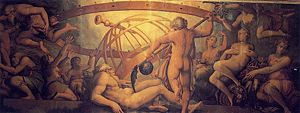Uranus (mythology)
Uranus (IPA: /ˈjʊərənəs, jʊˈreɪnəs/) is the Latinized form of Ouranos (Οὐρανός), the Greek word for sky. In Greek mythology Uranus is personified as the son and husband of Gaia, Mother Earth (Hesiod, Theogony). Uranus and Gaia were ancestors of most of the Greek gods. Uranus is revered as Father Heaven.
Other sources claim a different parentage of Ouranos. Cicero, in De Natura Deorum ("The Nature of the Gods") claims that he was the offspring of the ancient gods Aether and Hemera. According to the Orphic Hymns, Ouranos was the son of the personification of night, Nyx.
His equivalent in Roman mythology was Caelus, likewise from caelum the Latin word for "sky".
Creation myth

In the Olympian creation myth, as Hesiod tells it in Theogony, Uranus came every single night to cover the earth and mate with Gaia, but he hated the children she bore him. Hesiod names the Titans, six sons and six daughters, the one-hundred-armed giants (Hecatonchires) and the one-eyed giants, the Cyclopes. Uranus imprisoned Gaia's youngest children in Tartarus, deep within Earth, where they caused pain to Gaia. She shaped a great flint-bladed sickle and asked her sons to castrate Uranus. Only Cronus, youngest of the Titans, was willing: he ambushed his father and castrated him, casting the severed testicles into the sea. For this fearful deed, Uranus called his sons Titanes Theoi, or "Straining Gods"[1].
From the blood which spilled from Uranus onto the Earth came forth the Gigantes, the three avenging Furies — the Erinyes — Meliae, the ash-tree nymphs and according to some, the Telchines. From the genitals in the sea came forth Aphrodite. Some say the bloodied sickle was buried in the earth and from this was born the fabulous Phaeacian tribe.
After Uranus was deposed, Cronus re-imprisoned the Hecatonchires and Cyclopes in Tartarus. Uranus and Gaia then prophesied that Cronus in turn was destined to be overthrown by his own son, and so the Titan attempted to avoid this fate by devouring his young. Zeus, through deception by his mother Rhea, avoided this fate.
These ancient myths of distant origins were not expressed in cults among the Hellenes (Kerenyi p. 20). The function of Uranus is as the vanquished god of an elder time, before real time began. After his castration, the Sky came no more to cover the Earth at night, but held to its place, and "the original begetting came to an end" (Kerenyi).
Uranus was scarcely regarded as anthropomorphic, aside from the genitalia in the castration myth. He was simply the sky, which was conceived by the ancients as an overarching dome or roof of bronze, held in place (or turned on an axis) by the Titan Atlas.
Cultural context of flint
The detail of the sickle's being flint rather than bronze or even iron was retained by Greek mythographers (though neglected by Roman ones). Knapped flints as cutting edges were set in wooden or bone sickles in the late Neolithic, before the onset of the Bronze Age. Such sickles may have survived latest in ritual contexts where metal was taboo, but the detail, which was retained by classical Greeks, suggests the antiquity of the mytheme.
Robert Graves' and others' identification of the name Ouranos with the Hindu Varuna is widely rejected. The most probable etymology is from Proto-Greek *worsanos, from a PIE root *wers- "to moisten, to drip" (referring to the rain).
Planet Uranus
The ancients Greeks and Romans knew of only five 'wandering stars' (Greek: πλανεται, planetai): Mercury, Venus, Mars, Jupiter and Saturn. Following the discovery of a sixth planet in the 18th century, the name Uranus was chosen as the logical addition to the series: for Mars (Ares in Greek) was the son of Jupiter, Jupiter (Zeus) the son of Saturn, and Saturn (Cronus) the son of Uranus.
Consorts/Children
All the offspring of Uranus are with Gaia, save Aphrodite, born when Cronus castrated him and cast his severed genitalia into the sea (Thalassa).
- Cyclopes, one-eyed giants
- Brontes
- Steropes
- Arges
- Hecatonchires, hundred handed, fifty headed giants
- Briareus
- Cottus
- Gyes
- Titans, the elder gods
- Coeus
- Crius
- Cronus
- Hyperion
- Iapetus
- Mnemosyne
- Oceanus
- Phoebe
- Rhea
- Tethys
- Theia
- Themis
- Erinyes, the three Furies.
- Alecto
- Megaera
- Tisiphone
- Gigantes, the giants
- Alcyoneus
- Athos
- Clytias
- Enceladus
- Echion
- Meliae, the ash-tree nymphs.
- Aphrodite
Notes
- ↑ Modern etymology suggests that the linguistic origin of Τιτάνες lies on the pre-Greek level.
ReferencesISBN links support NWE through referral fees
- Kerenyi, Carl, 1951. The Gods of the Greeks
- Graves, Robert, revised edition, 1960. The Greek Myths.
External links
- Theoi Project, Ouranos references to Uranus in classical literature
- Greek Mythology Link, Titans summary of Uranus myth
Credits
New World Encyclopedia writers and editors rewrote and completed the Wikipedia article in accordance with New World Encyclopedia standards. This article abides by terms of the Creative Commons CC-by-sa 3.0 License (CC-by-sa), which may be used and disseminated with proper attribution. Credit is due under the terms of this license that can reference both the New World Encyclopedia contributors and the selfless volunteer contributors of the Wikimedia Foundation. To cite this article click here for a list of acceptable citing formats.The history of earlier contributions by wikipedians is accessible to researchers here:
The history of this article since it was imported to New World Encyclopedia:
Note: Some restrictions may apply to use of individual images which are separately licensed.